Archive for the ‘#hiddeninplainview’ Tag
Feel Your Way…….
Hidy Ho Good Neighbors,
So, have you tried Euro style nymphing yet? I know, sounds funny coming from a guy that wrote a book about the systematic approach to nymphing, but I have done a fair amount of this technique over the last couple of years. Even have my clients working a modified euro system on pretty much every guide trip.
Now, I’m no expert on euro style, but I appear to be qualified enough to talk about it because my clients catch plenty of fish, even on the first time out, using my quirky method. I tagged my method “eurorado nymphing” because it includes Colorado nymphing methods coupled with euro-style principles. I’ve included a section in my latest book, Hidden in Plain View, that goes into greater depth on what I do.

A good stocking stuffer
Suspended nymphing under an indicator still has a place in my arsenal as it can create longer more consistent drifts, gives you the ability to work water that is more than a couple rod lengths away, and gives you the ability to see fish eats thru the indicator. However, the ability to work the upper half of a drift effectively while dialing in drift speeds is a bit tougher under an indicator. Think back to the last time you nymph fished, how many fish did you catch upstream of the halfway point of your drift? Exactly, it’s hard to recall because it just doesn’t happen as often as the fish you catch from the middle to end of the nymph drift. That’s because that is when most anglers have the depth and speed finally perfect.
Eurorado style, on the other hand, allows you to work the upper part of the drift well. It allows you to feel working over obstructions, shelves and bars. And, you catch the majority of the fish above the middle point of your drift, because you get the bugs down quickly, and dial in depth and speed quickly after your bugs hit the water. Each method has its merits, but like I always say, the more versatile an angler you are, the more you’ll enjoy the sport.
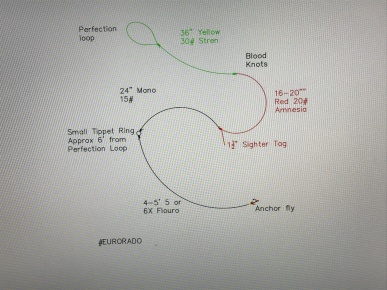
Customize as needed
Some days Eurorado nymphing is like a vacuum, picking up fish in a river where suspended nymphing wouldn’t be able to and it’s relatively easy to rig and learn. Again, I’m no expert, but there are many videos available that can get you started. As for gear, I run a 10’6” 3 weight Master Nymph Bellator fly rod with a matching Lamson Liquid reel. This rig is balanced and light weight with incredible accuracy and fish fighting capabilities. I also employ a sighter-leader of my design and use bugs of my design.
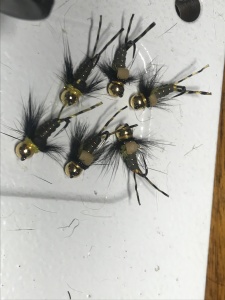
A gaggle of Booby Traps
The sighter-leader and flies used is where I put the “rado” in this rig, because it smacks of Colorado nymphing. Most Euro-style leaders are around twenty feet (and longer) lengths, whereas my leader is around eleven feet long. It is comprised of several different sections of monofilament, fluorocarbon, and amnesia lines, with a sighter tag and tippet ring thrown in for a cause (see pic). As for my bugs, I run a weighted Booby Trap, as my anchor, and run in-line off of that. So, off the bend of the Booby Trap, I run tippet to a DP643 which is an unweighted soft hackle, and off of that bend I run a Butt Crack Baetis (unweighted) in the appropriate size and color. I’m sure you can see the indicator nymphing influence here.
This rig has served me and my clients well over the last couple of years on the Eagle River, and it can easily be customized to your favorite water with a little thought and tinkering. I continue to learn a bit more each time my boots get wet, but I am sold on this technique. I really enjoy the simplicity, ability to feel your way along a river bottom, and the consistency to get depths and speeds dialed in quickly on every drift.
That’s my story and I’m sticking to it…….Fear No Water!
Happy Holidays!
Hidy Ho Good Neighbors,
I pulled on the zipper for the last time as the fabric separated from the zipper and the zipper slide became lodged on the teeth. This is quite disconcerting as you’re knee deep in the river with no way to ensure your fly boxes aren’t going to become refugees. I hadn’t put more than one hundred guide trips on the waist pack I had and it was not showing the durability of previous gear from this manufacturer. Right then and there I decided to look into a different company to supply me another waist pack.
I’ve dealt with Umpqua gear in the past and was always satisfied with their performance and durability. My Tongass pack has never let me down as I have traveled the country with it, floated down several rivers, and even went for a few unplanned dips in the water with it on my back. Each instance, the pack has answered the durability bell and kept my expensive camera gear bone dry. I chose the Umpqua Ledges 650 waist pack in hopes that it would perform equally as well.
I just completed my sixtieth guide trip with the new pack and I like it very much. Every piece of gear in my old waist pack fit nicely in the Ledges 650 and left space for more gear than I typically carry. The large compartment has a leaf installed that helps keep your boxes separate and organized. Boxes slide in and out without issue. The pack is very comfortable to wear as the wide hip belt and shoulder straps are well padded and ergonomically justified. I especially like the plastic plate between where your hip and the bag meet. This allows the pack to freely slide around your torso without catching your waders and coming to a quick halt. This feature also provides a space between the pack and angler that keeps one from overheating on those hot summer afternoons.
The fabric is very durable, well stitched, and for what it’s worth, I like the color patterns. The zippers, ahh the zippers, my usual nemesis, have worked unerringly. The zippers are incredibly hard core, over-sized, and the pulls are reinforced, dipped, and will take a pretty good tug over and over again. Point blank durability at its finest.
Speaking of zippers, I do have a slight issue with the placement of the main compartment zipper. I have found it difficult at times to open or close that compartment because the zippers are in close proximity to my body and it’s tough to get the zipper started as you open or close the compartment. My opinion is that in the next generation, the designers may want to look at moving that zipper to the front of the bag. It’s not a show-stopper for me; it’s just that everything else with this pack is perfect, why not this too?
There are a couple of sleeper amenities on this pack that are worth their weight in gold. In the front there’s a great slot to carry forceps. I carry two spares in there. Also, under the used fly pad, there’s a neat compartment for whatever where I carry my thermometer, and below that is a zippered pocket where I carry extra leaders and my phone. I really like the compartments on the belt straps; I carry my weights, dry shake, extra lighter, and a fly puck in those. The front elastic pockets are a handy “get-to-fast” feature, and the compartments behind those are hard to overfill with tippet, pucks, or a cigar or two. This pack just has it going on.
Overall, I give this pack a very high rating, and I have only had it a third of a season. I expect it to age gracefully and keep me well supplied and comfortable for its entire life. Thanks Umpqua, for another fine piece of fly fishing gear.
Fear No Water!
Duane
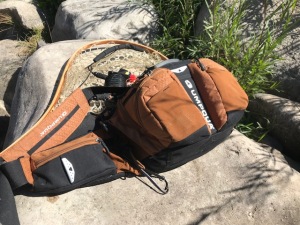

Of Redds and Run-off
Every year I hear the same old crap about folks ripping spawning fish off Redds. Drives me crazy, infuriates me really. How can you interrupt something as sacred as spawning fish? That’s our guarantee for future fishing, and there ain’t nothing wrong with wild fish, or the fish helping out in the quest for more fish. Our respective game and fish departments can’t do it all.
Maybe some folks just don’t know what to look for, so here goes: look for water up to about thirty inches deep with areas that looked like they’ve been swept with a broom. Usually, this is a flatter section of the river, with slower moving water. Also, look for one or more fish sitting atop this swept out area. I’ve seen redds the size of a coffee table, up to the size of an auditorium. Both are equally easy to spot if you’re paying attention.
You may be thinking, “So where do I fish then?” The answer is simple, “Not on the redd, but above or below it.” Target the species not spawning on the shelves and pools below spawning fish. Hmmmmm, wonder what patterns to throw…You can certainly toss egg patterns in your nymph rigs and follow that up with the fly of the day, or the dominant hatching insect. No mystery, really, just do your best to be observant, step around the redds, and fish anywhere but on them.
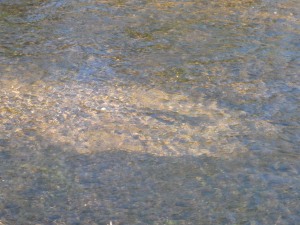
Pretty dang obvious Redd. Just observe.
Run-off is bearing down on us as the water rises and goes off color. My day usually starts out nymphing two and three bug rigs under an indicator, using darker and sparser bugs. I like weighted flies (odd for me, but conditions call for it), with dark and sparse materials, to get the bugs down quickly and allow the fish to readily see them. The darker colors are easier for fish to see in off-color water. I tie my favorite flies in black, purple, red, and even throw in some true fluorescent orange and pink collars to provide for “hot-spots” and visibility.
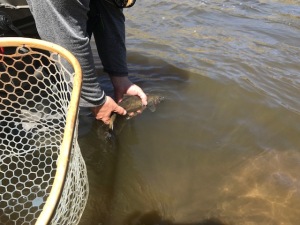
Little dirt in the drink.
Lately, my days have been ending throwing the mini-rig (it’s in the book), with a black Chubby Chernobyl followed by a black soft hackle (DP643), and a size 18 purple Butt Crack Baetis. Killer. The fish are moving to the edges and up into the riffles (not redds) to consume baetis swimmers and emergers, and the occasional skwala stones and migdes. You’ve all heard me preach about carrying two rigged rods, well this time of year is perfect for it. So, mornings I work bottom up, afternoons, top down.
Don’t hesitate to rip streamers as the water’s rising, that can be as productive as it is fun. I like to run tandem rigs with a white or lightly colored streamer up front, followed by a Slumpbuster or similar 20# below on 2 or 3 X tippet. I like to tie a loop knot to the trailing streamer to allow for a bit more movement. Typically, I’ll run a five to six foot tapered leader down to 2 or 3X to my first streamer, tie off the bend with the same to my terminal meat. If you’re not moving fish, you’re probably above their level, so employ more weight, casting angles, or mending techniques to get those streamers deeper. Vary your retrieves, strip set, and hang on.
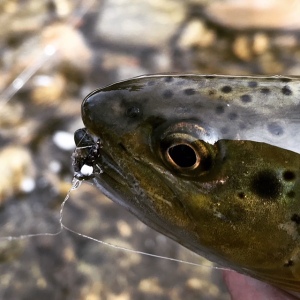
Black soft-hackles during run-off
As we get into full-blown chaos with run-off, focus on the banks, edges, eddy’s, and sleeper seams out from the banks. Just be damn careful stepping into crazy water. Dress appropriately, use a wading staff, take a friend, and show discretion and common sense. It’s not worth dying for.
A few nymphs to consider for run-off:
Black Pat’s Rubberlegs
Black Leeches
Cranefly Larva
Black Soft-Hackles (#16-18)
Purple Butt Crack Baetis (#18)
Purple, Pink or Red San Juan Worm
Various Egg patterns
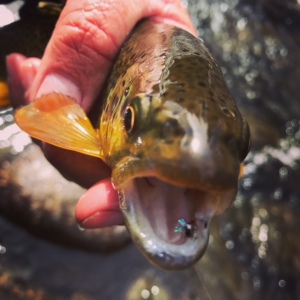
Purple Butt Crack Baetis
Fear No Water…except during run-off
Hidy Ho Good Neighbors,
I feel like I beat this subject to death, but it’s that important. Heck, it’s critical to fly fishing success. Whether your nymphing, dry-dropping, mini-rigging, skinny rigging, or dry fly fishing, keeping those flies flowing like the naturals in the Y seam to positioned fish is a skill to master.
Think of drinking your latte this morning, your mug went directly to your mug! In other words, you didn’t have to think twice about the path to your mouth, nor did you have to move to collide with the cup. It flowed to your mouth naturally. I contend, that if feeding fish have to move to eat your flies that are drifting unnaturally in the current, they will most often pass yours up to eat the naturals that are flowing perfectly. Fish see thousands of natural bugs drifting in the currents every day, if you can’t match that drift, you’re in for long days.
The Y seam is rarely if ever a straight line, it’s usually drifting to or away from you. Often it’s a combination of both, and fish set-up in advantageous spots, that make feeding on “real” bugs almost effortless. Don’t make them work for a meal. Strive to stay at proper depths and speeds as you stay in the Y seam.
I have uploaded a video for you to watch at: https://youtu.be/Up8EUzO0RxM
As always, find this and more explained in my latest book, Hidden in Plain View (Amazon)
Hit me with questions and comments, share the video with your fishing buddies, and Fear No Water!
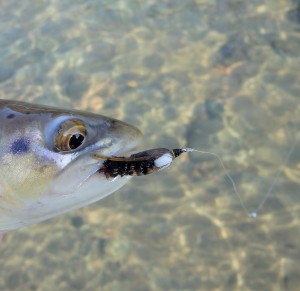
Directly to this face! Master the Y seam drift!
Hidy Ho Good Neighbors,
Once again, the speaking circuit is up and running. Just got back from Atlanta, and getting ready to head to Texas for the GRTU Troutfest. In between, I will have a couple chances to get on the water, tie a few bugs, and tighten up my speaking game. It’s a whole different world this time of year.
Buzzing around the country talking with so many anglers is quite humbling and extra enjoyable. I sat with Lincoln Westby (look him up if you don’t know who he is) for two full days last week at the Atlanta show, just picking his brain. At seventy plus years of age he is still incredibly passionate about this sport. I was humbled and truly thankful for that opportunity, plus I picked up more than a few tips. I bump into all kinds of people that teach me loads simply by the questions they ask. Many times, I have to stop and think on their question, which forces me to make ask them questions, make choices, clarify, or quantify a stance on a particular subject. Doing this tends to sharpen ones focus, and steel ones opinions.
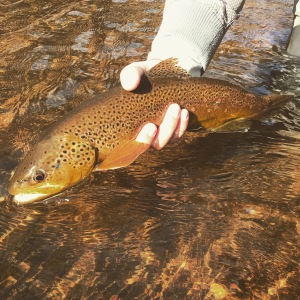
@rodcuffs releasing a South Platte Brownie
Once I begin to sharpen focus on a subject then I begin to dig into my reasoning for believing one way or another, and every now and then, I change my stance on a previously held thought. Sometimes, however, I stop, cock my head to one side and think, “Nope, not going to believe that.”
At a show last year, I was walking by the casting pool as someone was presenting to a group of anglers. This presenter was talking about setting the hook techniques, and had the fly rod pointing down to the opposite end of the pool as the point was made. With line out in the pool, and a large management loop formed from the index finger on the cork, this person proceeded to explain a dry fly set. “Reach up here with your left hand, grab the fly line up here above the cork, and pull hard to the side as fast as possible.” I stopped in mid stride at the edge of the pool just to confirm what I thought I heard. Yup, that’s what I heard.
So, in front of your management loop, you reach up with your off-hand grabbing the fly line and pulling to the side for the set. This alignment renders your loop worthless. What if you happen to hook the fish? Then, you’d have to take the line in your off hand and put it back under your index finger on the cork, just to begin to fight the fish. This is as hard to explain as it is to be believe. So, imagine you’re holding the fly rod in your right hand, and the management loop is created between your index finger on the cork and the fly reel. See it? Now, a fish eats so you need to set. Take your left hand and reach above your cork hand (toward the fly rod tip), and grab the fly line between the first line guide and the cork, above your hand. Pull it tight, out to the side, quickly.
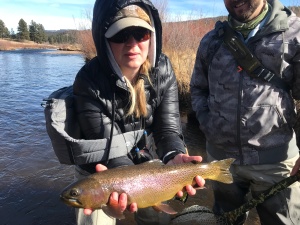
Nice winter fish for this sweet lady
I don’t get it. Usually when I hear something like that I can find some merit, or reasoning. I am still stumped many months after hearing this, and have shared this story with many in hopes someone could enlighten me. Not being a jerk here, but honestly trying to figure out what I am missing, because I just might learn something. Shoot me a note with any theories. You can’t ask a stupid question here, or give a stupid response, it’s all about learning.
The Eagle River has some shelf ice up high, and downstream you’ll find smaller amounts. The lower river has been checking in at about 38 degrees at ten in the morning, and warms up to about 41 degree on full sun days. Midges are coming off, and I (and the fish) are already beginning to look for Blue-Winged Olives. Not a bad idea to throw a pink San Juan, Black Soft Hackled PT, and a Buttcrack Baetis in that order, if you’re so inclined. Other combinations will work equally as well as long as depth and speed are dialed in. Go low and slow.
The latest book (Hidden in Plain View) is still doing well. Thanks again everyone.
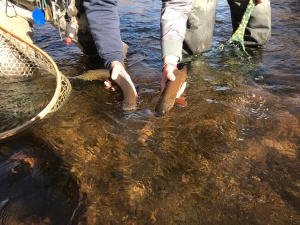
Sweet release times two….
Fear No Water!
Duane
Hidy Ho Good Neighbors!
Folks insinuate all of the time that as a fly fishing guide, all I do is stand in the water and bark orders. Couldn’t be further from the truth. I often will count my steps on my phone app, and I’m regularly in the six mile range when I guide six continuous hours or more. More often than that, by 9am in the morning, I’ve already sweated through my hat. Not all days are like that but those of us that wade guide hustle a bit more than folks think.
Guiding is a lifestyle and I wouldn’t have it any other way. I enjoy zipping back and forth between clients, landing fish, teaching, and yes, even untangling leader and tippet explosions. I enjoy the outdoors, sights and sounds, driving to the river with expectations, tying bugs the night before, and battling Mother Nature everyday anew. I enjoy the grind, dipping my hat in the drink because it’s so damn hot, dodging thunder storms, sunscreen burning my eyes, freezing my finger tips, the physical exertion, and the challenge. I like sitting on my tailgate behind the fly shop, guzzling a well-earned beer and smoking my pipe at the end of a long day on the river.
Couple years ago in July, and I remember it as if it were yesterday, I began the day with 3 clients from Ohio. We fished near Wolcott on the Eagle River for about six hours, and had a pretty successful outing with many fish hitting the bottom of the net. On my way back to the shop, toting my clients, I get a call from one of our managers. “Hey D, this is so-and-so, got one of your regulars in the shop, he just hit town unexpectantly and wants to know if you can give him four hours this afternoon on the river.” “Ah, sure” I reply, trying to not get my clients involved in the conversation. “Good, ok”, says my manager and he squeezes in the next words without taking a breath, “Can you hoof it?” “He has late dinner plans for tonight.” “I’m about twenty minutes out”, I say.
I love doing “doubles”, but I’m rarely prepared for that call. If I know they’re booked, it’s much easier to transition from trip to trip than finding out last minute. I had plans, like a nap, maybe go fish a bit, or hang out with my colleagues. No worries, I’ll make this happen, but I have a routine that I like to follow. I like to re-rig all of my rigs with fresh bugs and tippet the night before my next day trip. I like to go through a physical and mental checklist, I hate to be hurried prior to a trip, and I like to be at least an hour early before a guide trip. In this circumstance, I had none of those. Not only am I a creature of habit, but I’m a bit superstitious…..I have learned to not let this kind of stuff bump me off my game.
I dropped my clients off at the municipal lot down the street from the shop. Knowing my client was waiting for me at the shop, I decided to take a five minute break right where I was, and try to find something to eat and drink. My cooler revealed I had 4 waters left, one warm beer,and I was out of snacks. That’s the other thing I was going to do, hit the supermarket for drinks and goodies. Oh well, I needed to save the water for sure, but I’m thirsty as heck, “Guess I’ll pound the warm beer”, I thought out loud. I dropped the tailgate and took a good guzzle of warm suds. Just then it dawned on me, yesterday I bought a bagel at the supermarket before my trip, “Where did I leave that?”. I started rummaging through the backseat looking for that blueberry bagel. I reached under the front seat and found pay dirt. Yes, warm beer and a blueberry bagel for lunch! One of the best lunches I ever had.
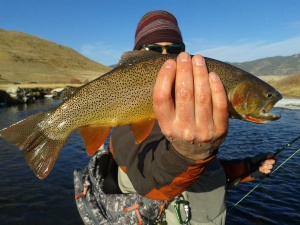
Winter spoils
I went out with my client that afternoon and we threw dry flies for about four hours. Can’t get much better than that. No, guiding is not the toughest job in the world, but it does have its challenges. Now when someone asks me how my day went, I usually reply, “I was outstanding in the river.” Ya, I know, guide humor ain’t much, but it’s better than a beer and a bagel.
The Eagle River has been fishing well this winter. Little shelf ice, clear water and active fish has made for a good start to 2018. We desperately need snow though, so if you live within 1000 miles of us, send some our way.

Butt Crack Midge for winter.
Humbled to say the book is doing well. Thanks to all of you who has purchased a copy of Hidden in Plain View. Review it on Amazon if you’re so inclined, or shoot me a note letting me know your thoughts. Thanks again!
Fear No Water!!!

Thank you!
Hidy Ho Good Neighbors!
“I probably would’ve set on that”. “I didn’t even see it move”, he replied. I said automatically, “Yea, we need to keep working on the take recognition”. All too often, I watch fish after fish eat our offerings and nothing is done on the business side of the fly rod. Doesn’t matter, it could be an eat on the swing, lift, drift or surface, and nothing happens.
I’m beyond getting frustrated with clients when they don’t recognize a fish eating their offerings; I try instead, to use it as a teaching tool. Breaking down the missed opportunity right after the fact, seems to more completely reinforce the need and timing of something that should have been set upon, than beating them over the head with it. And, like magic, once they relax and hook a few, they begin to recognize more eats and set more quickly.
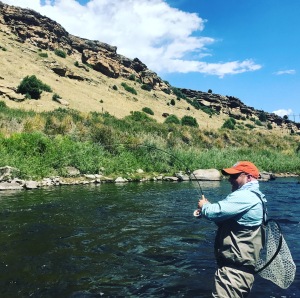
The more you set correctly, the more solid hook-ups you create….
I think most folks, even my experienced clients, that miss fish are usually preoccupied with working on another skill, and/or are overwhelmed with tougher drifts. The tougher the drift, the more mending, and the more difficult it becomes to babysit the drift. Many times clients miss takes because they are watching their hands and the fly line to ensure a good drift, and lose focus on the indicator, indicator fly (dry-dropper), or the dry fly on the surface. Sometimes, when working on advanced skills, such as, pause and go mending, folks again lose focus on the take, and miss fish. It’s easy to do.
So, how do you fix this? What do you do if you are continually missing fish? Simplify. In this case, simplification takes place in two ways: doing less while perfecting more. Perfect the ability to mend without taking your eyes off of the indicator, sighter leader, dry fly, or indicator fly. As you become more proficient at having both hands work as one, you will begin to do less, work less, and simplify the drift. So, the first simplification is teaching the hands to work together, next skill is to stop out-casting your coverage.
Out-casting your coverage begins when you have too much line out for your skill level. I believe in healthy management loops below the reel, and large slack mends if your skill level calls for it, but once you feel as if you are continually mending in your drift and can’t keep up, be honest and realize you’ve hit your limit. No shame in that, just keep working to increase your coverage. Again, simplify.

Don’t out-kick your drift ability coverage.
This sounds basic, but many folks don’t really know how to set once they do recognize an eat. All sets are not created equal. Nymph drift sets are a low sweeping motion downstream over the water. You must set the distance required to actually straighten out the line to pierce the lip. Many folks set quickly enough, but “short-set” and never straighten the line. The dry fly and dry-dropper set are usually downstream over the downstream shoulder. Much less force is applied than the nymph set because there’s not as much drag on the rig, and too much force can result in a snap-off. Be careful to set “against the fish” when setting on a dry fly, striving to set from the fish’s head to its tail. Streamer sets are completed by using your stripping hand to set the hook by pulling the management loop back toward your butt pants pocket as if you’re completing a large streamer strip. Again, these are simple sets, but require a bit of practice.
A few other tidbits: strive to learn to “vicinity set”. Try to set on any fish flash within the vicinity of your flies. For example: if you’re running a nymph rig 8 feet from indicator to your last fly, set on any fish flash within four feet of the indicator. More often than not, if you set on a fish flash within the vicinity of your drift, you’ll move a fish. If you are sight fishing, and can see the fish, learn to set on fish movement. If the fish are feeding side-to-side, set when they swing to one side and stop, before returning to their position. Same thing if fish are porpoising, set when they stop, before they go back down to their original position.
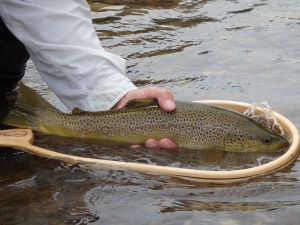
The reward after a fine battle.

There’s much more to cover here, and I go into great detail in my next book, Hidden in Plain View. The book is now in pre-sales, I think you’ll like it. It was recently the number one new fishing book, so I’m pretty pleased with that. Amazon, Barnes and Noble are offering presale discounts for a short time.
Simplify, simplify, simplify, and Fear No Water!
Duane
Hidy Ho Good Neighbors!
“We had our July in August” That’s what I told one of our young guns the other day before we headed to different spots on the same river. What an odd season it has been. Usually, I can somewhat predict flows and clarity pre, during, and post run-off, but this year, like last, has been confusing to say the least. July fished like August for the second straight year with somewhat picky fish, hot air and water temps, and a high sky. We were all scratching our heads as to what was going on. “Then the rains came……..”
We endured several run-offs this year. Gone are the days when you could bank on a steady, concerted melt and drain. It would start, then stop, then start again. Seems like it started in April and was done this year in late July, statistics prove that out. That lack of consistency really makes you scratch your head at times as to where the fish are holding and why. They aren’t following the typical patterns to movement because the typical patterns no longer exist. The flows this year averaged about twenty percent higher than norm until just a few weeks ago, so the fish didn’t spread out in earnest until late July. Only then did we start consistently catching fish in the faster and shallower riffles.

Fish ate a dropper in the mini rig for Thomas.
But wait there’s more! Typically, after the 4th of July, all I throw is the Mini Rig. This rig allows me to cover water from 6” to nearly 4 feet deep fairly effectively. It’s all I ever needed after the fourth all the way into late October. This year, because of flows, torrential afternoon rains, cold water temps, and funky fish holds, I found myself using the nymph rig more and more, while the Mini Rig sat idle on the bank. Gotta fish ‘em where they’re feeding consistently, so nymphing ruled the day until about two weeks ago.

One of the last nymphed fish this season.
Now the flows are perfect, the water is gin clear, and small quills and tricos are coming off. It’s been a Mini Rig domination the last two weeks, backed up by double dry rigs and an occasional streamer or nymphing rake. Back right where she should be, even though temps hit the mid-thirties a couple mornings last week. I’ll take it, means fall is on the way, big orange sedges, trico spinner falls, pseudo-baetis, and hoppers on the edges. Plenty of water this year, so I guess it’s ok to have that many run-offs after all. Mama Nature knows what she’s doing.

Eric with a fish that ate a dry. Cherry series 8′ 4wt- 8 Rivers Fly Rods
Just a couple quick notes:
I am building next year’s speaking schedule, so if you know of any club or organization looking for a fly fishing speaker feel free to contact me.
Hidden In Plain View is going well. I am knee deep into the photo and illustration portion, and loving every minute of it. Looks like a mid November completion date.
And lastly,
The Butt Crack baetis made it into the Montana Fly Catalog. It’ll be available, along with the Butt Crack Midge, early next spring.

Butt Crack baetis- My go to fly most of the year…..Coming to a fly shop near you!
Fear No Water!
Hidy Ho Good Neighbors!
Wow, been too long since I last posted, but I’ve been a busy dude. Just spent the last eight to ten weeks cranking out the text for my next book project. I’m really fired up about this book, and am looking for an on the shelf date of late 2017. The text is done except for countless edits, but that’s never been the hard part for me. The hard part is all of the charts, graphs, illustrations and pictures. Going to rely on some talented friends to help out with all of that. Speaking of friends, I asked four from around the country, at various stages of their perspective fishing careers to read and edit for flow, content, etc. I really appreciate their help, and they will have special mention in the book.
First book was out on June of 2011, second came out in December 2014, this one hopefully, in December 2017. Notice a pattern there? What it tells me is that it takes me about three years to learn enough new stuff to be able to write another book. That’s thousands of hours of on the water observations, note taking, and data collection. I was on the river yesterday and someone shouted to me the river temperature, and I honestly didn’t care. Oh, I will in a couple of weeks when the Blue Wings start popping, but yesterday was a diversion from the book day, so I simply nodded it off.
I am still amazed at what I glean from simple water time in a relatively short time. It shows I’m paying attention AND there’s still more to learn! A lot more! This next book uses statistical information from hours and hours of dedicated note taking to flesh out the best techniques and flies to use as you progress on your fly fishing journey. It’s going to be roughly 55,000 words, plenty of illustrations and pictures should round it out. This years presentation is called Hidden In Plain View, and folks across the country seem to like it. The presentation mirrors the book as it gets into being able to recognize the obvious and exploit the obscure in fly fishing. It should have something for every level angler, and covers tactics from mini/skinny, double dry fly, nymphing, and streamer work. Crazy fun.
So, with all that going on, I haven’t had much time to work on my annual winter technique. Most that have followed for a while will recall that I pick something to work on every winter during slack times in the season. This year, I decided to continue what I was working on last winter and last 2 years guiding seasons. I’ve been working on this covertly, simply because I didn’t feel as if it was ready to unveil. It’s no mind blasting technique, but I wanted to have the specifics dialed in before telling anyone about it. In the last three years I have begun to use “sighter” leaders in my suspended or hinged nymph rigs. A sighter leader allows the angler many benefits, but mostly for this indicator fishing it helps detect very subtle eats, and it gives you a great idea of what your rig is doing sub-surface in relation to your indicator. It’s a specialized leader I build using various poundages and colors of amnesia and monofilament lines. A few of the knot tags are left un-trimmed and further the sight capabilities.
Many anglers don’t even realize what is going on sub-surface in regards to the indicator. We are so dialed into surface mending, that we don’t think about subsurface mending. We can see what is going on surface wise because of our fly line, but it’s often difficult to discern what is going on below the indicator. The sighter leader fixes that because it will clue you in as to when your leader turns over the indicator, and where your flies are at pretty much anytime within the drift. This has been a huge help to many of my clients as they begin to see how a few specialty mends can effect the entire sub-surface drift. They then can learn and employ a pile, stack, or pause mend with great effectiveness and confidence, because the results are observable through the sighter.
Here’s the formula for one of my leaders, this is all you get til the book comes out! Try this, I think you’ll like it:
36″- 20 pound Yellow Amnesia
30″ – 14 pound clear Monofilament
24″ – 10 pound Red Amnesia
Connect everything with a blood knot, and if you wish use a tippet ring at the end of the 10 pound red amnesia, it’s a fine idea. From the tippet ring attach your 16″ of 4x, 5x, or whatever mono or flouro to your first fly. You can place your split shot above the tippet ring to complete your in-line nymph rig.

Upstream sighter leader work. Photo James Durden.
I was fishing this rig just yesterday and noticed and set on the sighter movement more than a few times. The indicator never even twitched. It does take a bit of practice to use the sighter because it forces you to keep the indicator in your peripheral vision and use it as a secondary device. This just adds to your angling versatility as you begin to fish the entire vicinity around the nymph rig.
Anyway, enough for now. I’ll be better with more consistent posts. Til then, get out and fish the sighter.
Fear No Water!

Notice the blood knot tag location…mono to red amnesia line.


























